In today’s world, time is of great importance. What was relevant yesterday is no longer relevant today. Therefore, companies are constantly looking for ways to accelerate product development and bring it to market. Competent IT specialists are required to meet this need, and finding them takes a very long time.
That is why such models as outsourcing and outstaffing have gained popularity. They help solve issues with finding and hiring employees, as well as people, shortening the project implementation period.
However, there are many myths about these models. Most people do not fully understand their differences. As a result, it turns out that business owners are simply forced to turn to contractors who, unfortunately, do not solve the assigned tasks but waste money and time.
Today, we will try to arrange everything on the shelves. We will help you to find answers to such common questions as “When outsourcing is not profitable,” “What companies should avoid when considering outsourcing,” “What is outstaffing,” and many others. Are you ready? Then, let’s get started.
What are the IT outsourcing and outstaffing models?
We will start with the definition of these models and then consider their advantages and disadvantages. This will help you to make the smart choice, depending on your project’s requirements.
Outsourcing model: definition
This model involves one company hiring another to develop complex software on a turnkey basis. In this case, the client does not participate in the management and control of the software development team. The client does not hire employees, and the supplier is responsible for the final result. Speaking briefly, outsourcing is when a company delegates work that it cannot do on its own.
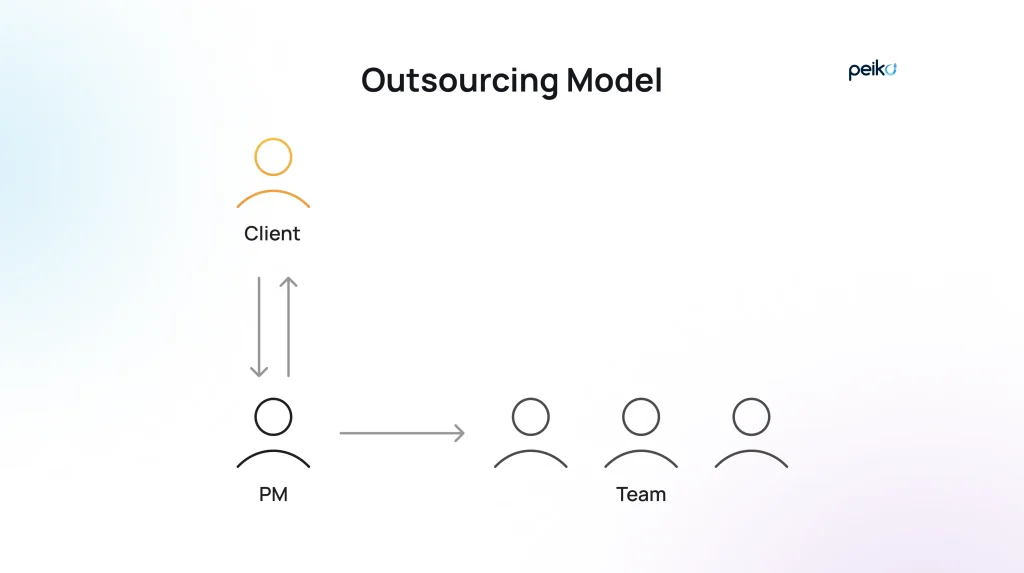
Outstaffing model: definition
This is one type of remote employment where an outstaffing company provides dedicated employees to perform tasks depending on your needs. They become part of the client’s team.
The customer is fully responsible for the personnel management process. However, they are not a direct employer. The IT outstaffer is responsible for wages, bonuses, and finding performers. At the same time, the customer is responsible for the result.
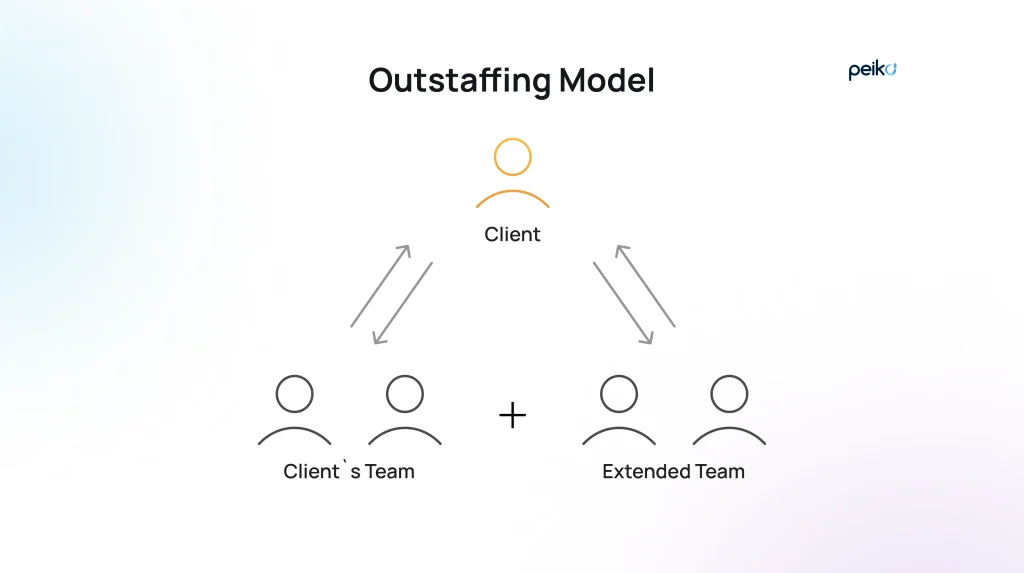
Key differences between these two models
This is a never-ending topic of conversation. Many people confuse the terms, but there is a big difference between outsourcing vs. outstaffing.
The main thing to remember is that outstaffing represents a model where a firm recruits dedicated professionals from an external source. These professionals subsequently merge with the firm’s internal team but remain on the provider’s payroll. The client oversees project management and ensures quality control while the outstaffed workers collaborate with the client’s in-house team.
On the other hand, outsourcing refers to the case when a company (client) hires another company. For example, the client hires a software outsourcing company to perform a contract for the entire project, from planning to development and testing.
Reasons to choose outsourcing and outstaffing
The popularity of outsourcing and outstaffing is growing nowadays. This is due to the many undeniable advantages that these models provide. For example, you do not need to do a talent search. You get substantial savings in money, time, and much more.
If we turn to Grand View Research, Inc., statistics show that global spending on outsourcing and outstaffing will grow by $936.6 billion by 2027. In other words, the rate is expected to grow by 7.7 percent each year until then.
In addition, access to sales markets is opened, where qualified personnel is much cheaper. For example, if you compare the hourly salaries of specialists from Ukraine and the USA, you will be surprised to see such a difference. Regarding the price-quality ratio, it is worth paying attention to Ukrainian developers.
Advantages and drawbacks of each of the models
Here, we will dive deeper into the pros and cons of each model – outsourcing vs. outstaffing. The business owner should consider the nuances of these models to make informed decisions that meet the project’s aims.
Outsourcing model: pros and cons
Below are the advantages and disadvantages the outsourcing model offers.
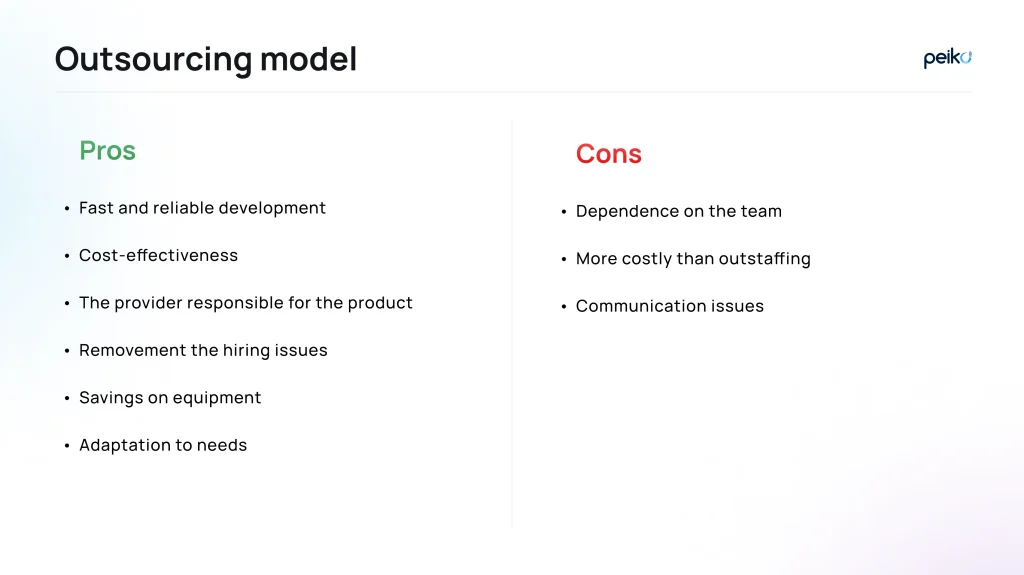
Outsourcing advantages:
Fast and reliable development
This means the client doesn’t have to deal with the hassle of hiring. Moreover, a professional outsourced team often brings experience in developing products specific to the client’s needs or within their niche. They may have experience in multiple similar projects, enabling them to commence work immediately without encountering many errors or difficulties.
Cost-effectiveness
You can hire such a team in a country with lower developer salaries. This means that the overall expenses can be reduced or the budget can be allocated more efficiently, even if the salary remains the same. Also, the client avoids paying for mistakes that internal developers typically make when unfamiliar with a client’s niche.
Responsible for the final product
The service provider assumes full control over the quality of the code and the project as a whole. For this purpose, a well-established project management team is functioning among its staff. You don’t have to go through the whole process. You get a ready-made solution where all management is left to the service provider, from communication to execution.
Removement the hiring issue
When a company outsources, human resources issues are handled by the supplier. You don’t hire employees, you don’t pay taxes for them, and you don’t collect salaries. You voice the needs, and the outsourcing company gathers the necessary number of professionals with the appropriate qualifications for implementation.
Savings on office equipment
There is no need to buy additional equipment, rent space, or buy the software. In general, all this is already included in the cost of services and is more profitable.
Adaptation to needs
The outsourcing company responds quickly to emerging requests. For instance, your business needs to accomplish a small task that just takes a few hours. The supplier can provide a specialist without their subsequent involvement in the project.
Outsourcing disadvantages:
Dependence on the development team
The client’s complete dependence on the development team emphasizes the importance of carefully selecting a team with a proven track record and positive reviews.
It is crucial to exercise caution and make wise choices when it comes to team selection, as there is always a potential risk of hiring an incompatible team, which may only become apparent after some time and the loss of both time and resources.
Therefore, select teams based on reputable reviews from platforms such as Upwork, Clutch, and GoodFirms to reduce this risk.
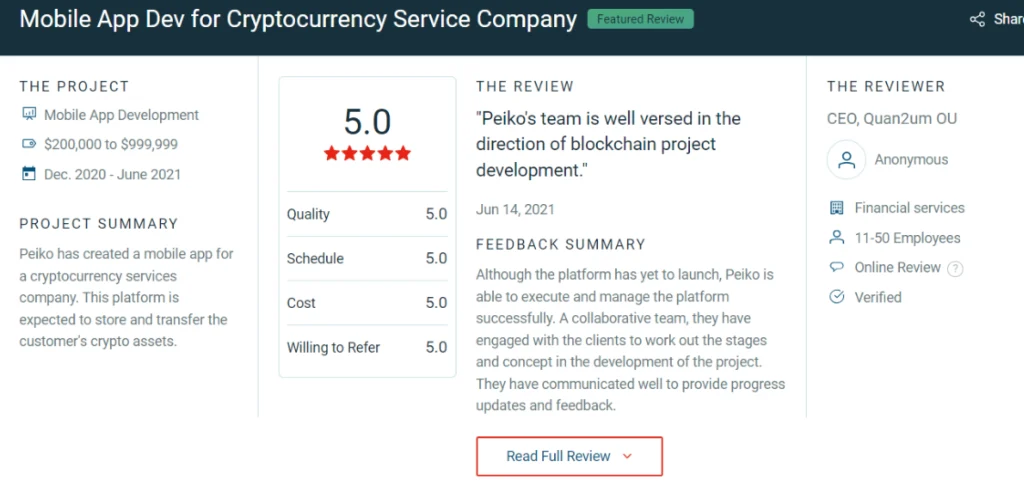
More costly than outstaffing
For smaller projects with a duration of up to a month, it may not be practical to seek out teams. This can often result in higher costs without the client experiencing substantial benefits from collaborating with a team.
Communication issues
In certain cases, communication may only occur through the project manager, and the developers may not be fluent in the client’s language. Consequently, there can be potential losses in translation. So, it is crucial for companies to prioritize effective communication to ensure high-quality outcomes.
Outstaffing model: pros and cons
Let’s consider which benefits and drawbacks can bring the outstaffing model.
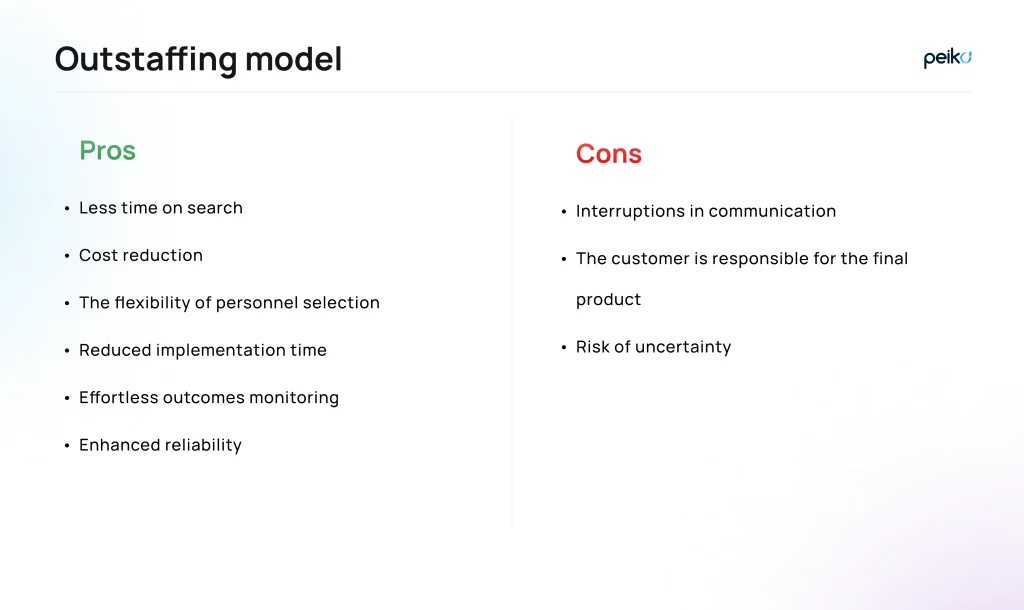
Outstaffing pros:
Less time on search
Accordingly, you receive proven specialists who fully meet the company’s needs. You do not waste time searching and checking. All this is undertaken by the IT outstaffer.
Cost reduction
All costs related to taxes and insurance are paid by the staffing provider. It’s important to mention that there is no requirement to provide compensation for termination, which amounts to a substantial sum.
Additionally, there is no need to cover expenses for equipment and other associated costs. You, as a customer, get a ready-made solution in the form of dedicated developers.
The flexibility of personnel selection
You completely free yourself from issues related to personnel turnover, and you can also flexibly manage the size of the team. If suddenly you need to increase or decrease the number of employees, it will not take long.
Reduced implementation time
One of the key benefits of opting for outstaffing in software development is the streamlined implementation process. This method significantly reduces the time needed for project deployment, ensuring swift and effective outcomes within the project’s timeline.
Effortless outcomes monitoring
You’ll have direct visibility into the completed tasks. This enables the client to evaluate the performance of their outstaff developers.
Enhanced reliability
Picking a team with the same level of reliability as a remote outsourcing company poses challenges. The team you engage is not on your payroll but serves as your contractor. Their commitment remains steadfast as long as they receive fair compensation and incentives for hard work. So, it’s a more reliable way to hire professionals provided by a trusted outstaffing firm rather than a simple freelancer from Fiverr or other sites.
Outstaffing cons:
Interruptions in communication
When working remotely, there is a risk of poor integration into the regular team. However, this can be avoided if you properly prepare for the adaptation process. Also, if the employees are multinational, you may face misunderstandings related to cultural differences.
The customer is responsible for the final product
Management is carried out by employees on the client’s side. This means that the responsibility for the final result lies with the customer.
Risk of uncertainty
Primarily, it involves the potential of losing your top developers. When engaging an outstaffing agency, it’s essential to focus on the working conditions within these agencies. The greater the benefits agencies offer, the higher the likelihood that your developer will remain with the company (along with your projects).
Outsourcing vs outstaffing: comparison table
To choose wisely between these two models, let’s delve into a comprehensive comparison table that summarizes their core distinctions.
| Outsourcing | Outstaffing | |
|---|---|---|
| Aim | Comprehensive implementation of the project by a third-party organization and the possibility of creating or rebuilding a product from the very beginning | Providing the customer with qualified employees with special experience and knowledge |
| Place of employment | Remote employment, in the framework of which the client receives the specified results. The work schedule is set by the service provider | The employee becomes part of the client’s staff. Coordination of the schedule and working conditions is carried out on the client’s side |
| Client participation | In this case, the client orders the services. It does not monitor the ways and means of execution, nor does it control the personnel | The employees are transferred under the control of the customer company. Therefore, it takes responsibility for the result |
| Development time | The onset of development is quicker | It takes time to define the specifications and build the right team |
| Payment | The client’s company is responsible for the payment | This model means the regular receipt of wages by employees |
| Legal responsibility | The service provider company takes responsibility for legal compliance | The client is responsible for legal compliance |
| Time zones | Work is possible in diverse time zones | Differences in time zones can lead to issues in communication with the team |
| Scalability | High scalability, the team can handle large-scale projects | Better for smaller projects |
| Flexibility | More rigid format | More flexible format |
The key differences between software outstaffing and outsourcing are the project’s scope and the party that takes responsibility for managing the development processes. Outsourcing also means hiring freelancers and dedicated employees, and outsourcing can be recommended when turnkey services are required.
Choosing between outsourcing vs outstaffing model
To answer this question, you only need to consider your own needs, your available resources, and your business model in general. Surely, selecting the outstaffing vs outsourcing models can be challenging. But we have written this article to assist you.
Opt for the outsourcing model if:
- You have a complete project or a wide scope of activities to deliver.
- Internal capacity or technical expertise is lacking.
- Project management tasks need to be delegated to a tech partner.
Choose the outstaffing model if:
- The entire project delivery isn’t mandatory; it could involve specific ongoing business activities.
- You possess sufficient technical competence to manage a team of engineers productively.
Here’s a quick guide to help you make a choice when you are looking for a team to create a project from scratch.
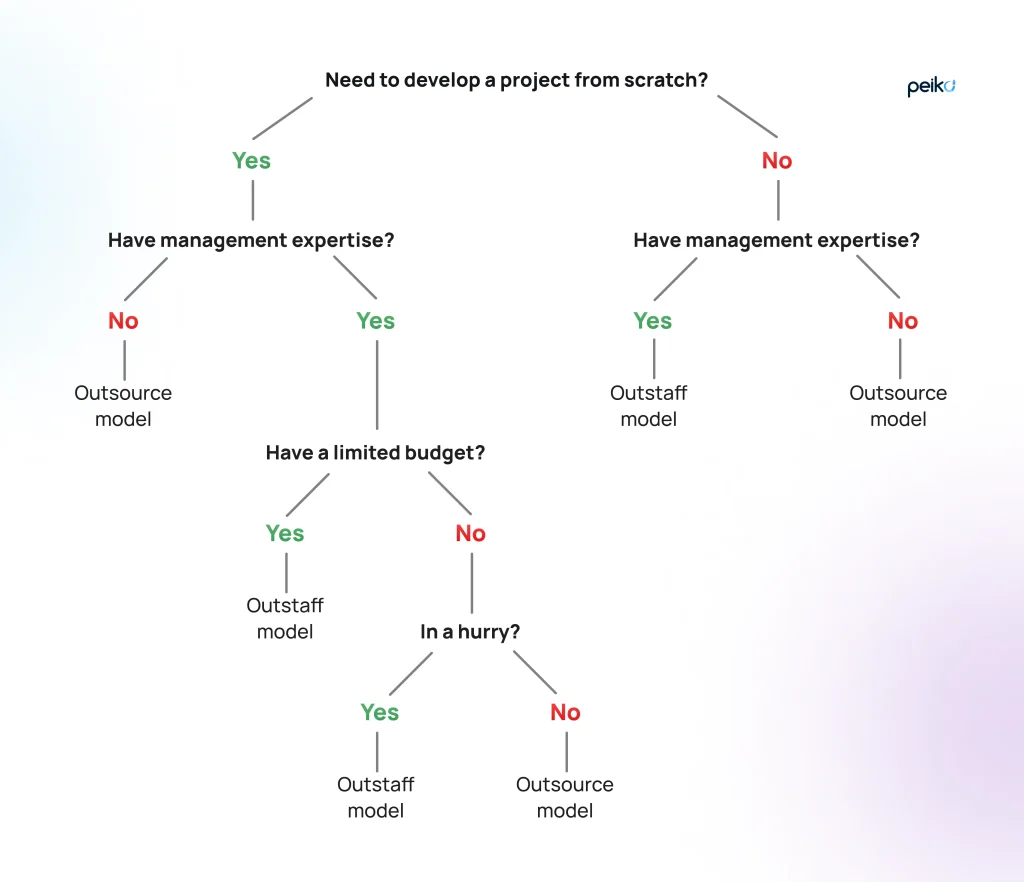
Now, let’s consider picking a suitable model with an example. Let’s say you have a vision to launch a project in the cryptocurrency sphere, like a decentralized exchange (DEX), for instance. You recognize the importance of initiating this venture within a week or two to seize the trend and attract a larger user base. However, you lack the time to search for developers and endure months of collaboration.
In such cases, it is ideal to engage a proficient outsourcing team with prior experience in similar projects, enabling them to commence work promptly and deliver a high-quality product within a short timeframe.
If, for example, you have a limited budget or a clear time frame to meet, then an experienced outstaff team will always help. The choice is yours.
Some tips to find a reliable team
When you pick a company for project development, we recommend paying attention to the points below to identify a trustworthy and proficient partner:
Reviews and reputation
Conduct thorough research on the partner’s reputation. Read feedback from their previous clients. Gauge the overall customer perception to assess the company’s reliability and commitment.
Experience and qualification
You should evaluate the team’s specialization in your business field. Consider experience in similar projects. Such a background will enhance the efficiency of collaboration. Also, ensure the partner has a team of qualified specialists capable of efficiently handling your tasks, ensuring a high standard of work.
Data security and legal compliance
Discuss data security matters and establish relevant agreements to safeguard the confidentiality of your information. Furthermore, investigate potential legal concerns regarding payment and billing in their jurisdiction.
Transparency and communication
Regular updates and clear feedback keep you informed about project progress for timely decision-making. You should understand the team’s reporting mechanisms.
Cultural compatibility
Check for alignment in company values and culture between you and your partner to prevent conflicts and misunderstandings during collaboration. Moreover, ensure the vendor’s time zone fits you.
Flexible approach
Seek a partner willing to adapt to the changing needs of your business. Flexibility in client collaboration can significantly impact project outcomes. You can request a comprehensive workflow description during the initial discussions. The team should explain to you how much does it cost to build a blockchain project and provide a clear estimate.
If the development company meets all your requirements, it’s a perfect match.
Models of cooperation at Peiko
Our company is a reputable custom software development services provider with a team of 67 specialists. Recognized as the top development team by many trusted resources, such as Clutch, GoodFirms, and others, we prioritize collaboration, quality, client satisfaction, flexibility, and innovation.
Our team of professionals crafts highly intricate and sophisticated web and mobile solutions and provides high-quality blockchain development services. We foster growth and success for both startups and major brands through innovative technological solutions.
In the initial phase of development, we conduct a thorough analysis, shaping flexible solutions to meet individual client needs. Subsequently, the development stage unfolds with meticulous UX/UI design and advanced programming, bringing clients’ visions to life. Quality assurance is conducted through rigorous testing processes.
Also, in the post-release phase, Peiko continues to offer ongoing updates and consistent support. So, we guarantee sustained excellence in project performance.
If you need talented developers for your project, at Peiko, you have the option of choosing between 2 methods: software outsourcing and outstaffing.
Option №1: outstaffing model
At Peiko, we offer the option of hiring dedicated programmers on an outstaffing basis, whether it’s full-time, part-time, or on an hourly arrangement. Our skilled developers are committed to long-term engagements and can be paid either on an hourly or monthly basis.
We prioritize open communication and take care of all technical and salary-related matters. If needed, we are also willing to sign a non-disclosure agreement (NDA) to ensure transparency and confidentiality. Your main responsibility will be to maintain regular communication with our programmers and ensure timely payment of their monthly salaries.
Option №2: outsourcing model
By choosing Peiko for your development outsourcing needs, you gain enhanced flexibility and numerous avenues to progress your future project.
Moreover, outsourcing not only helps in reducing costs but also aligns with your project requirements and budget. It expedites the delivery cycle, enabling you to identify the suitable company and convey your specifications within fixed timeframes. This streamlined process ensures efficient progress and prompt results.
Whatever interaction model you choose, you will receive a high-performing and reliable solution for your business.
One of the successful outsourcing projects created by Peiko
The Peiko team has significant experience in developing solutions that have taken our clients’ businesses to new heights.
For example, we are proud of one of our blockchain products. The Quan2um app we developed provides an efficient and seamless mobile application experience. This solution allows easy trading and monitoring of the dynamic cryptocurrency market. Using the app, individuals can experience the future of crypto transactions with convenience, speed, and unparalleled flexibility.
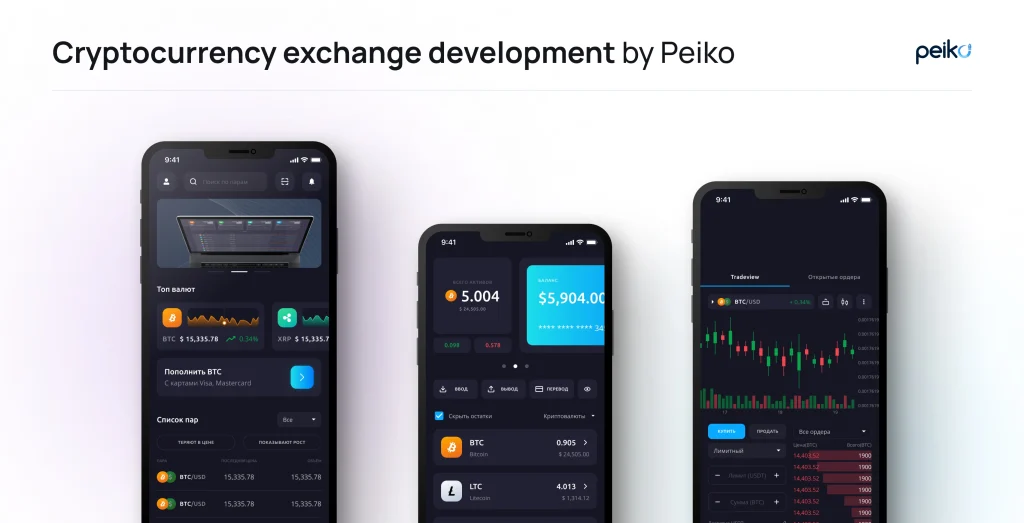
As a result of our work, the client got a secure and robust mobile solution with a modern design. We integrated functions for seamless fund deposits and withdrawals through the application and added the real-time trading feature. Also, the project is equipped with a tracking mechanism for monitoring the prices of crypto pairs, offering users real-time market insights.
To discover more top projects we created, check our portfolio, which includes efficient decentralized blockchain platforms like Orion Protocol, non-custodial wallets, crypto exchanges, and more.
If you are looking for how to start a crypto startup, turn to Peiko, and we will analyze your idea and help to implement it.
Conclusion
In a highly competitive field, business owners need to be very fast in developing and recruiting a team of professionals to be the best. Therefore, the demand for freelancers is increasing every day. This approach allows for rapid development without harming the quality of the work performed and the company’s confident growth.
Whenever you choose software outsourcing or outstaffing, to get the desired result, it is necessary to approach the choice of a partner carefully. It should be a reliable company that really takes your needs into account. Weigh the pros and cons, and you will find the right solution to implement your idea.
When hiring the right development team for your project, we strongly recommend that you consider the goals and specifics of your project. Furthermore, be realistic about your capabilities in terms of managing the development process.
Feel free to contact us, and we will advise you on the best flow according to your project and business needs!
No comments yet. Be the first to comment!











